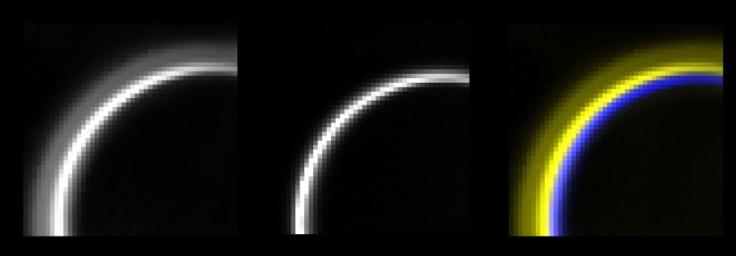A high-altitude haze layer residing some 400 kilometers (249 miles) above the surface of Titan is seen here traced along the limb of Titan as silhouetted against the glow of Titan's atmosphere produced by the fluorescence of methane gas. This detached haze layer can be seen as a dark lane imbedded within the gold-colored fluorescent layers of Titan.
This image of Titan's limb and surface was obtained by the Cassini spacecraft's visual infrared mapping spectrometer on Dec. 13, 2004 from a vantage point some 158,000 kilometers (98,177 miles) above the night side of Titan, at a phase angle of 161 degrees. Beneath the fluorescence, Titan's surface at the extreme limb can be seen in blue color, illuminated by 5-micron wavelength sunlight that penetrates the thick atmosphere and hazes to reflect off the limb of Titan. The darkness of the silhouetted haze layer comprised of relatively small particles (less than the 3 micron wavelength of light) suggests to scientists that the particles themselves absorb strongly at the fluorescent wavelength (3.3 microns), and thus are possibly comprised of relatively complex hydrocarbon aerosols generated by photochemical processes in Titan's upper atmosphere.
The Cassini-Huygens mission is a cooperative project of NASA, the European Space Agency and the Italian Space Agency. The Jet Propulsion Laboratory, a division of the California Institute of Technology in Pasadena, manages the Cassini-Huygens mission for NASA's Science Mission Directorate, Washington, D.C. The Cassini orbiter and its two onboard cameras were designed, developed and assembled at JPL. The visual and infrared mapping spectrometer team is based at the University of Arizona, Tucson.
For more information about the Cassini-Huygens mission visit, http://saturn.jpl.nasa.gov. For more information about the visual and infrared mapping spectrometer visit http://wwwvims.lpl.arizona.edu/.

 Planetary Data System
Planetary Data System












